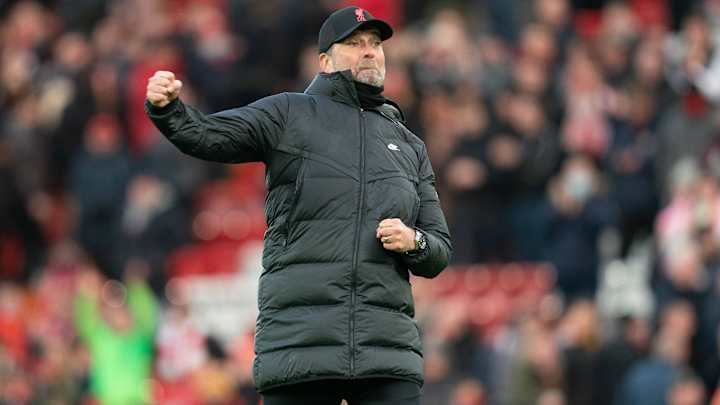Klopp’s Commitment Fortifies Liverpool’s Outlook for the Future

Jürgen Klopp had always seemed clear he would leave Liverpool in 2024 when he will be 57, largely it seemed because he felt putting a cap on his reign would help avoid the sort of staleness that contributed to his struggles in his final season at Borussia Dortmund. From that perspective the news last week that he had signed an extension to ’26 came as a surprise. But on the other hand, when everything is going this well, why would you want to leave?
What Klopp has achieved at Liverpool is extraordinary, and all the more so given it has been done on a (relatively) restricted budget. Liverpool is a super club and is complicit in the skewing of football’s finances so that only a handful can compete, but there are gradations. Since Klopp arrived in October 2015, Liverpool has spent a net £225 million and yet it is able to go toe-to-toe with Manchester City, which, in that same period, has spent a net £606 million.
As Liverpool faces Villarreal in the Champions League semifinals, a glance at the lineup from six years ago, when the sides met in the Europa League semifinals near the end of Klopp’s first season, is instructive. From Liverpool’s starting lineups, only two players remain: Roberto Firmino and James Milner, although Jordan Henderson, Divock Origi and Joe Gomez missed the second leg through injury.
But it’s the disparity in the qualities of the sides between then and now that is so striking. The Liverpool of six years ago was very clearly an upper Premier League side rather than a potential European champion. Current goalkeeper Alisson is a level above Simon Mignolet; Trent Alexander-Arnold and Andy Robertson are on another level compared to Nathaniel Clyne and Albert Moreno at fullback; Virgil van Dijk and Joël Matip or Ibrahima Konaté are far more solid than Dejan Lovren and Kolo Touré in central defense. The biggest creative star of that earlier side was Philippe Coutinho. Would any Liverpool fan swap him, even at his notional peak, for the current iterations of Sadio Mané or Luis Díaz?
Watch Liverpool online in Champions League games with fuboTV: Start with a 7-day free trial!
Those net transfer figures are, of course, conditioned by the sale of Coutinho, and by Barcelona’s desperation to spend the money it had received for Neymar. But still, Liverpool had to deal with losing a player many had thought it could build its future around, and it had to spend the money well. As Tottenham showed after the sale of Gareth Bale, it’s very easy to squander a transfer windfall. But Liverpool has found a structure that works.
There were the signings of Ben Davies and Ozan Kabak last season, but those were cheap emergency signings to try to cover a freakish series of injuries to central defenders, but otherwise it feels that every signing Liverpool has made for years has been a good one. Who was the last player who arrived for any kind of substantial fee who has not been a success? Alex Oxlade-Chamberlain, perhaps, but he suffered a serious knee injury. Christian Benteke, brought in for £42 million in the summer of 2015—pre-Klopp—is probably the last. That speaks of a remarkable efficiency and harmony between the scouting, recruitment and coaching arms of the club.
The other obvious difference between now and that last Villarreal tie is the comparative strength in depth. Back then, the bench was completed with two goalkeepers, Danny Ward and Brad Smith, and Spanish midfielder Pedro Chirivella (a total of eight Liverpool starts between them). These days, the likes of Takumi Minamino and Harvey Elliott have a desperate fight even to be named as a substitute.
That has a knock-on effect. Mohamed Salah and Mané are out of contract after next season. Both have—not unreasonably, given they could probably double their salaries elsewhere—sought a significant wage rise. Liverpool would still probably rather keep them, but now the club can set a limit, as it has no need to break its salary structure. In Diogo Jota and Díaz, there are replacements already in situ. And Salah and Mané, perhaps, will look at the structure around them, at a team in which they fit perfectly and a squad that has depth in all positions—with the vast majority of the core under contract through at least 2024—and wonder where they could go that would offer such an exciting environment, or what wages could compensate for leaving one of the greatest of all club sides in what, even after the successes of the past three years, could still be its greatest period.
Klopp extending his deal may help clarify the thinking. In six years he has transformed the club. The next two or three years are when the benefits should be harvested, starting Tuesday in Spain with what should be progression to a third Champions League final in five years. A historic quadruple remains in play. Klopp likes how the future looks. Others may join him.
More Soccer Coverage:
- Klopp Extends His Liverpool Contract Through 2026
- Ancelotti Makes History With Real Madrid’s La Liga Title
- Wilson: Liverpool’s Patience, Power Pay Off vs. Villarreal
Sports Illustrated may receive compensation for some links to products and services on this website.

An accomplished author of multiple books, Jonathan Wilson is one of the world’s preeminent minds on soccer tactics and history.